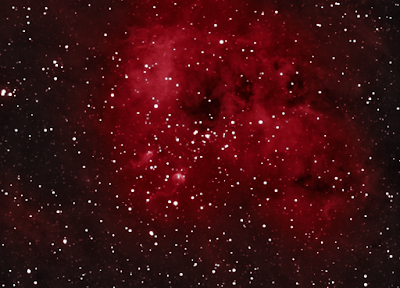HaOIIIGr-St.png)
This is a false color version of the Pacman Nebula, NGC 281. In this version, Ha is green, OIII is blue, and Green is red. I know that is odd, because OIII lies within the Green band, and that is why there is very little yellow in the image, unlike some narrowband versions posted around the web (which also record sulphur emission as red). I don't mind the effect at all, though.
The Pacman Nebula is about 10,000 light years away and over 80 lights years wide. It lies in the constellation Cassiopeia. The cluster of stars at its center excites the cloud of gas so that the gas glows. The energy and particles streaming from the stars in the cluster are slowly pushing the gas away. Where denser gas exists, the wind stream sculpts out the gas surrounding it to leave pillars and peaks (along the bottom edge of the nebula) that will itself eventually wear away. Unexcited gas that remains densely clumped looks black.
My favorite image of this nebula is at
http://www.astrofotografia.com.pl/photogallery/ngc281_rc/ngc281.htm That one really is an awesome image, taken with a much bigger scope and a camera that can fit the whole nebula in even at a much longer focal length. I also like
this one from Ken Crawford.
Imaging Scope: Orion 80ED & WO 0.8x II (f/6)
Imager: Atik 16
Exposure: 38x5' in Ha; 21x5' in Green; 41x5' in OIII (8 hours, 20 minutes total)
Filter(s): Astronomik Ha (+NII); Meade Green; Astronomik OIII
Capture Software: Nebulosity 2
Mount: Takahashi EM-10
Guiding Camera: DSI Pro
Guiding Software: PHD
Guiding Scope: 60mm f/4 hybrid
Date: October & November 2009
Location: The Woodlands, TX
Processed with Nebulosity 2, Registar, & Photoshop Elements 7
Ha.png)
HaRed.png) This is the most dramatic part of a nebulous area (IC 410) in central Auriga. Here as in the Pacman Nebula, the brilliant stars in the central cluster (NGC 1893) excite the surrounding hydrogen gas. The stellar winds from these bright stars are also pushing away the gas from around other stars, including those stars in the two tadpoles just down and to the left of the cluster.
This is the most dramatic part of a nebulous area (IC 410) in central Auriga. Here as in the Pacman Nebula, the brilliant stars in the central cluster (NGC 1893) excite the surrounding hydrogen gas. The stellar winds from these bright stars are also pushing away the gas from around other stars, including those stars in the two tadpoles just down and to the left of the cluster.Ha.png)
HaRed.png)
HaOIIISII-M2.png)
HaOIIISII.png)
HaOIIISII-HSI.png)
HaOIIISII-1.png)
HaOIIISII-2.png)
HaOIIISII-4.png)
HaOIIIGr-St.png)
OIII.png)
OIIIGreen.png)
Ha.png)
HaRed.png)
OIII.png)
OIIIasGree.png)
Ha3.png)
HaFalseRed.png)